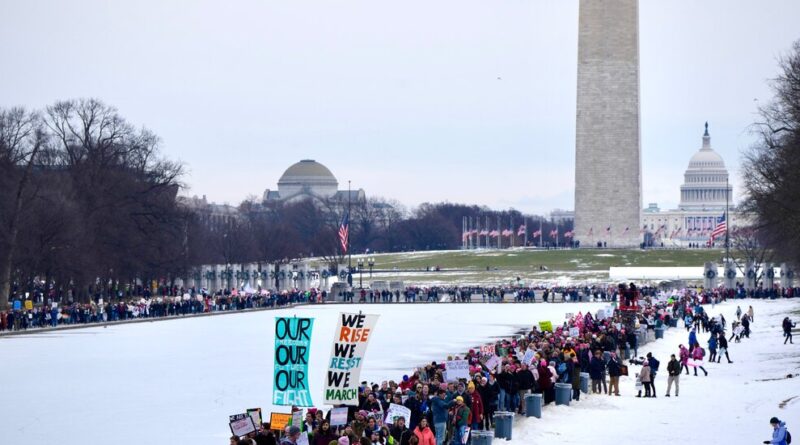Thousands Protest Trump’s Return to White House Days Before His Inauguration
Some climbed into buses in the wee hours of the morning. Others boarded planes from across the country or drove bleary-eyed through the night. No matter how they got to Washington on Saturday, they shared a common goal: to protest against President-elect Donald J. Trump.
Just two days before Mr. Trump’s inauguration, thousands of people attended the People’s March across Washington. Despite the damp and chilly weather on Saturday, demonstrators came out to rally against Mr. Trump’s hard-right plans for the country and show support for causes like civil rights, racial justice, immigration and gun violence prevention.
“I am angry and frustrated,” said Jillian Wheat, who came to the march from Columbus, Ohio, with her 14-year-old daughter, Emma. “I’m worried that he is going to dismantle our democracy.”
It was a sequel of sort to the Women’s March in 2017, which also was held around Inauguration Day. That one took place right after Mr. Trump was sworn in for his first term, and the protest focused on women’s reproductive rights. But for this iteration, the march was rebranded and expanded to include more people and a wider range of issues. Various sponsors, including the Sierra Club and Time to Act, a group against authoritarianism, backed the event on Saturday.
With signs that called Mr. Trump a felon, an oligarch and a danger to democracy — one read, “such a disaster that even grandmoms have to take to the streets to resist” — protesters yelled chants such as, “Stand up! Fight back!” and “No justice, no peace, no Trump,” at times injecting an expletive into the chant.
Many, if not most, attendees said they were nervous that Mr. Trump would try to roll back more rights they valued than he did in his first administration, during which he nominated Supreme Court justices who helped overturn Roe v. Wade. They were hoping that he would not strip away climate change protections and L.G.B.T.Q. rights, and that he would not follow through with his threat to carry out mass deportations of undocumented immigrants.
Debbie Pierce, a gerontologist from Tampa, Fla., wiped tears from her eyes as she held up a photo of a young relative who recently told her that she might be a lesbian.
“I’m here for her,” said Ms. Pierce, referring to her relative. “With this new administration, I don’t know if she will be safe.”
Alana Eichner, co-director of the local chapter of the National Domestic Workers Alliance, came to the march with more than a dozen women who work as caregivers for children and the elderly. She said she hopes that Mr. Trump realizes that domestic workers — including many who are undocumented — are essential to the American economy and help the country function.
“We’re here to make sure these workers are protected and valued,” she said, as the women she came with nodded in agreement.
On the dawn of a second Trump presidency, marches also were held in other cities, including New York, Nashville and Portland, Ore. Hundreds turned out in each of those cities, and at least 1,000 in Manhattan, with protesters marching with similar signs, chants and level of energy as the those in Washington.
Demonstrators across the country also singled out the billionaire Elon Musk, protesting what they thought was a path to oligarchy. In Washington, Ellen Marcus, who came from Hoboken, N.J., urged people to boycott companies owned by billionaires like Mr. Musk.
“Musk is the guy who bought Twitter and now he’s buying the president and he shouldn’t be anywhere near the White House,” Ms. Marcus said.
At the march in Portland, Jen Sellers, a physical therapist who was at the Washington march in 2017, said she was reminded that so many freedoms could be at stake under this Trump administration, including the one she was exercising on Saturday: the freedom to gather and speak out against the government.
“I know last time Trump was in office, he was using violence against protesters,” Ms. Sellers said. “I think this is one of the big issues, just our democracy.”
Even as many of Saturday’s protests saw a large turnout, they paled in comparison to the Women’s March eight years ago. At least 470,000 people were estimated to have packed into the nation’s capital in 2017, ready and energized to fight after his surprise defeat of Hillary Clinton. The protest turned into a sea of pink as many attendees wore pink knitted hats in solidarity..
This time, the crowd in Washington was smaller and the pink hats were sparse.
Mary Griffin, who flew to Washington from Seattle for both Saturday’s march and the one in 2017, said she was troubled by the lower turnout, recalling that people were squished together shoulder-to-shoulder at the first march. She said she suspects that voters for Vice President Kamala Harris are still in shock and “in the doldrums,” frozen about how to show their resistance to the new administration.
“We need to get our energy back,” said Ms. Griffin, a 63-year-old lawyer. “I think once Trump starts moving in the direction I think he’s going in, the pendulum will swing back and people will be energized again.”
Nate Schweber contributed reporting from New York, Jamie McGee from Nashville and Kimberly Cortez from Portland, Ore.

